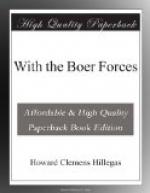While Ladysmith was being besieged by the Boers there were many interesting incidents in the laagers of the burghers, even if there was little of exciting interest. In the Staats Artillery there were many young Boers who were constantly inventing new forms of amusement for themselves and the older burghers, and some of the games were as hazardous as they seemed to be interesting to the participants.
The “Long Tom” on Bulwana Hill was fired only when the burghers were in the mood, but occasionally the artillery youths desired to amuse themselves, and then they operated the gun as rapidly as its mechanism would allow. When the big gun had been discharged, the young Boers were wont to climb on the top of the sandbags behind which it was concealed, and watch for the explosion of the shell in Ladysmith. After each shot from the Boer gun it was customary for the British to reply with one or more of their cannon and attempt to dislodge “Long Tom.” After seeing the flash of the British guns the burghers on the sandbags waited until they heard the report of the explosion, then called out, “I spy!” as a warning that the shell would be coming along in two or three seconds, and quietly jumped down behind the bags, while the missile passed over their retreats. It was a dangerous game, and the old burghers frequently warned them against playing it, but they continued it daily, and no one was ever injured. The men who operated the British and Boer heliographs at the Tugela were a witty lot, and they frequently held long conversations with each other when there were no messages to be sent or received by their respective officers. In February the Boer operator signalled to the British operator on the other side of the river and asked: “When is General Buller coming over here for that Christmas dinner? It is becoming cold and tasteless.” The good-natured Briton evaded the question and questioned him concerning the date of Paul Kruger’s coronation as King of South Africa. The long-distance conversation continued in the same vein, each operator trying to have amusement at the expense of the other. What probably was the most mirth-provoking communication between the two combatants in the early part of the campaign was the letter which Colonel Baden-Powell sent to General Snyman, late in December, and the reply to it.




